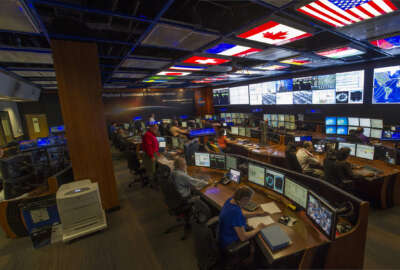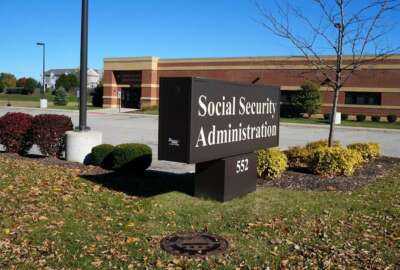Time for the ‘great resignation?’ Not for the federal government, CHCOs say
Agencies say they're trying to become more flexible, attract private sector workers looking for a change and retain current federal employees wanting to keep what...
Private sector companies might be dealing with a wave of employee resignations, but agency chief human capital officers said that inside the federal government, the situation is different.
At least for now.
Instead, chief human capital officers said their agencies are viewing the current moment as an opportunity, a chance for them to become more flexible, attract private sector workers looking for a change and retain current federal employees wanting to keep what they got a taste of during the pandemic.
“I do not think there is a great resignation ahead of us,” Traci DiMartini, chief human capital officer at the General Services Administration, said last week at a virtual AFCEA Bethesda event on workforce transformation. “I think there’s a great right-sizing ahead of us, particularly in the federal government.”
Agency human capital experts used multiple words and phrases to describe the moment.
Keith Krut, NASA’s chief of people analytics, described the current environment as the “great reevaluation,” a period where employees across public and private sectors are reconsidering what they want from their jobs. Employers, including NASA, are trying to quickly respond to their desires.
Wonzie Gardner, the chief human capital officer for the National Science Foundation, said he is seeing some long-time employees retire from his agency. But he said this moment of the “great retooling,” where agencies are rethinking what work means. Some are making full-time telework, remote work and other flexibilities permanent.
“This pandemic has been a catalyst for people to make decisions about where and what they want to do with the rest of their lives,” Gardner said. “As part of the federal enterprise, I look at it as how do we retool that particular job and be able to pivot to get more of the types of people we want for the 22nd century?”
Immigration and Customs Enforcement is working on its own workplace transformation initiative, one that involves shifting resources from brick-and-mortar facilities to people and technology.
“This is going to be the long-term strategy and plan for the agency, with which we are going to deliver an innovative and adaptable workplace model,” said Waldemar Rodriguez, associate director of ICE’s Office of Professional Responsibility. “The focus is going to be on mobility, flexibility and mission effectiveness. Coincidentally this fits very nicely with where we find ourselves today, where we’ve been the past year-and-a-half, and where we think we’ll be for the next couple of years. We want to create a workplace for the workforce that focuses on continuous engagement that reaches beyond legacy constraints. We’re very tied to physical facilities … but we want to go beyond those constraints to advance the mission by focusing on technology and people.”
DiMartini said she sees a similar opportunity to revolutionize work inside GSA and across government broadly, particularly as private sector industries compete for talent.
Attrition at GSA has been lower than normal during the last year, she said.
“We saw fewer people retire during the pandemic because they had the option to work from home or to perhaps move to a different locale,” DiMartini said. “So whereas someone may have thought, ‘I want to move to Florida. I want to move down south. I want to move somewhere to be closer to my grandkids; I should submit my retirement papers.’ They now said, ‘I can stay another two or three years and transition my work if you’ll allow me the option to make this a remote position.’ Before 2020 we would have never entertained that.”
That is an option now for GSA employees in certain positions. DiMartini said GSA has spent the last year categorizing its positions into three broad groups based on their mission requirements.
Category one includes positions that are tied to a particular building or site, she said. Category two encompasses positions where employees can telework — but within the bounds of a certain location that’s still geographically close to their colleagues and customers.
The third category includes positions that employees can perform from anywhere on a fully remote basis, DiMartini said.
“It’s been an interesting journey for us, because the focus is on the position and the work, not on personalities or people,” she said. “We have invited our staff to give us their input. This is about human beings. We have to really take a hard look at what our workforce needs, not just what they want, what they need.”
It doesn’t mean employees eligible for full-time telework must work from their homes every day, and agencies say it’ll take time for the workforce to settle on their preferences once traditional federal offices open more fully in the coming months.
GSA will begin its official reentry process on Jan. 4, though some employees have been working inside agency buildings throughout the pandemic, DiMartini said.
Both the Social Security Administration and the Agriculture Department are eyeing a Jan. 3 reentry date for at least some of their employees. Of course, all of this is subject to change, and the dates and plans have changed multiple times since the pandemic began last March.
The National Science Foundation has been trying to socialize the uncertainty with its workforce too, Gardner said.
Supervisors and agency leaders have to be comfortable telling their employees, “I don’t know,” he added.
“In years past and organizations past, it’s always been a stoic leader who stood up in front a crowd and looked like he knew everything. This is one of those times in our lives, our business lives, where bosses don’t know and where employees are afraid,” Gardner said. “We have to make sure as we muddle through this that we have a trust dividend, where people are willing to accept change and the uncomfortableness with change.”
It will take some time for federal employees to settle into new schedules and working arrangements once agencies allow more people back into their offices.
NASA has said it will spend the next year or so looking for patterns and preferences that might emerge once employees have the freedom to choose how and where they work.
GSA has said it too anticipates a period of time before work patterns normalize.
In the meantime, agencies are finding ways to improve or add training opportunities for employees, supervisors and leaders. The goal, CHCOs said, is to educate the workforce on how to communicate, operate and lead inside a hybrid workforce.
“We are reshaping how we work,” Wonzie Gardner, chief human capital officer at the National Science Foundation, said. “In order to reshape how we work, we have to retool and reskill and upskill everybody, not just leaders, but employees as well.”
NASA is experimenting with a training method that it’s calling “supervisor sprints.” Keith Krut, the agency’s director of People Analytics, said the sprints follow the agile methodology that agencies use when adopting new technology.
Rodriguez said ICE is expanding coaching opportunities to more employees inside the agency.
GSA is “beefing up” its leadership training as well, DiMartini said. The agency is trying to educate employees about what leading a team really means before they might become supervisor.
“In the last year we have opened executive coaching up to all of our Senior Executive Service and strongly encouraged them to have a coach,” she said. “This year in [fiscal] 2022 we’re going to expand that. We’re going to keep the coaching emmeshed in our culture and then step it up to cohort discussions. We’re going to start with things around topics that are very, very time sensitive, such as leading a hybrid workforce or dealing with organizational change management.”
Copyright © 2025 Federal News Network. All rights reserved. This website is not intended for users located within the European Economic Area.
Nicole Ogrysko is a reporter for Federal News Network focusing on the federal workforce and federal pay and benefits.
Follow @nogryskoWFED






